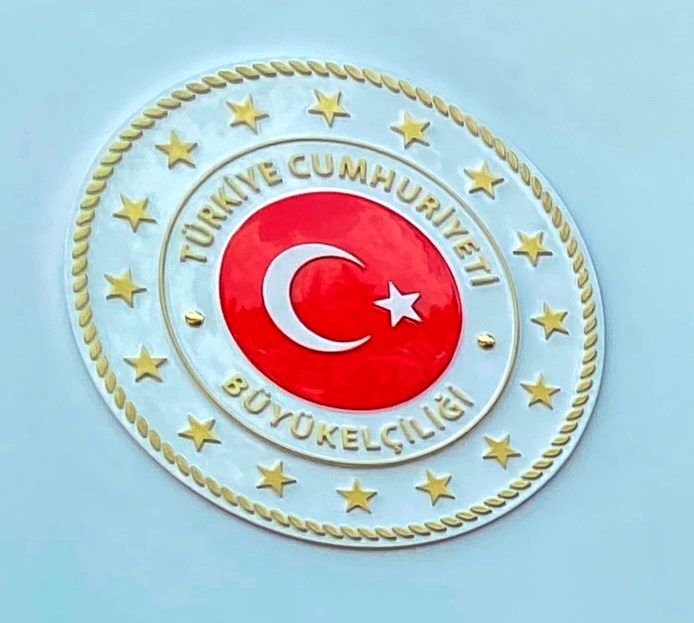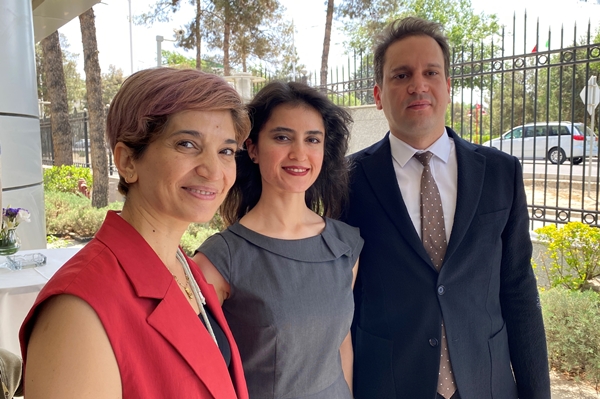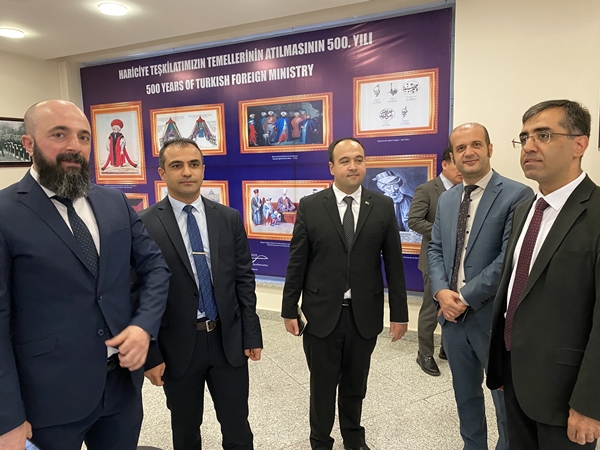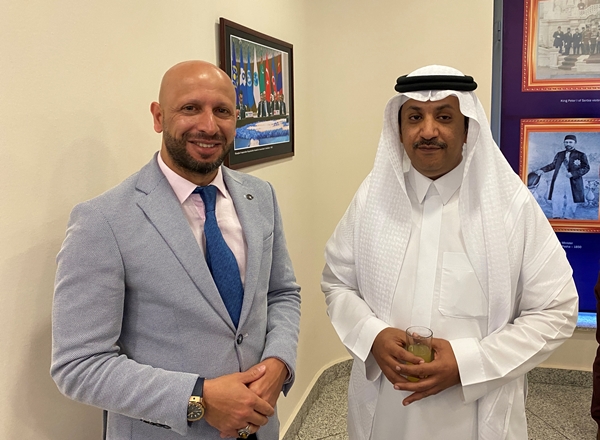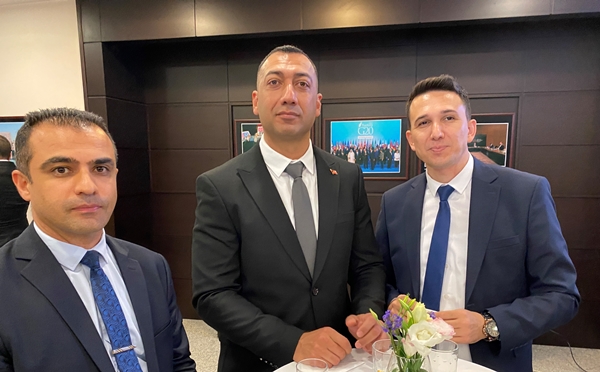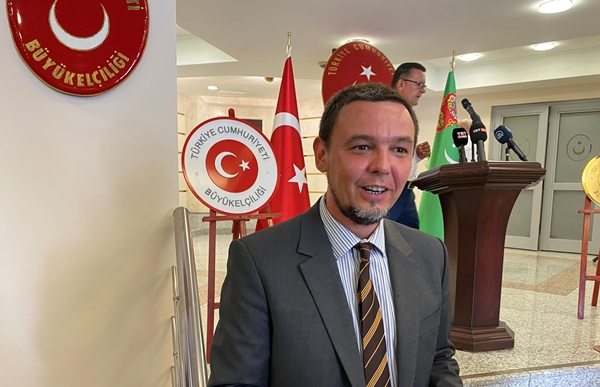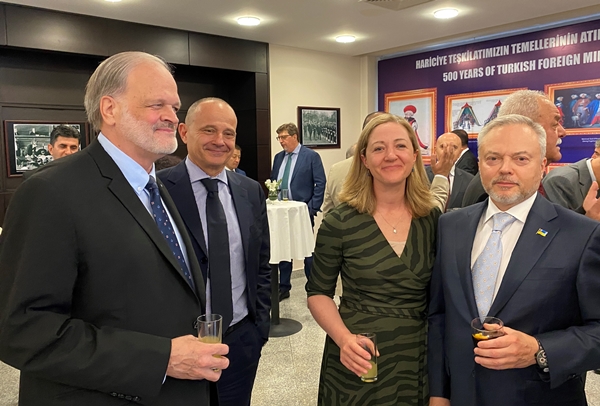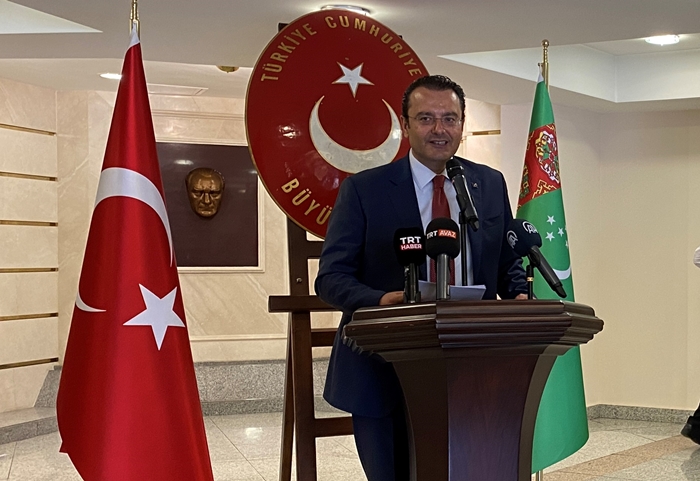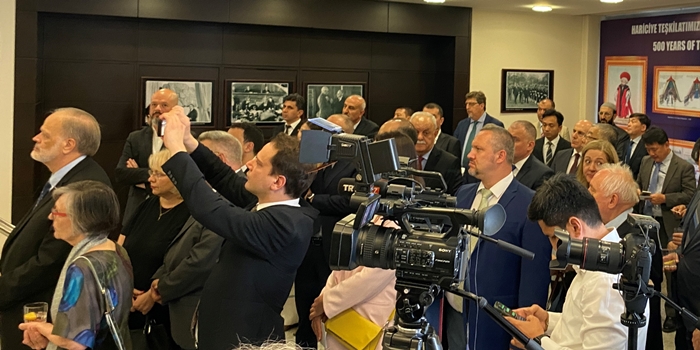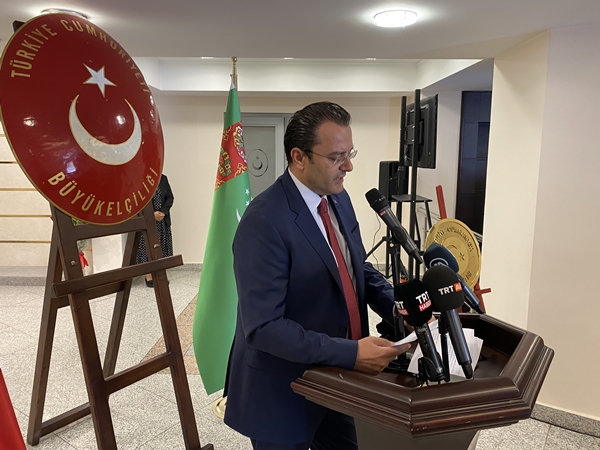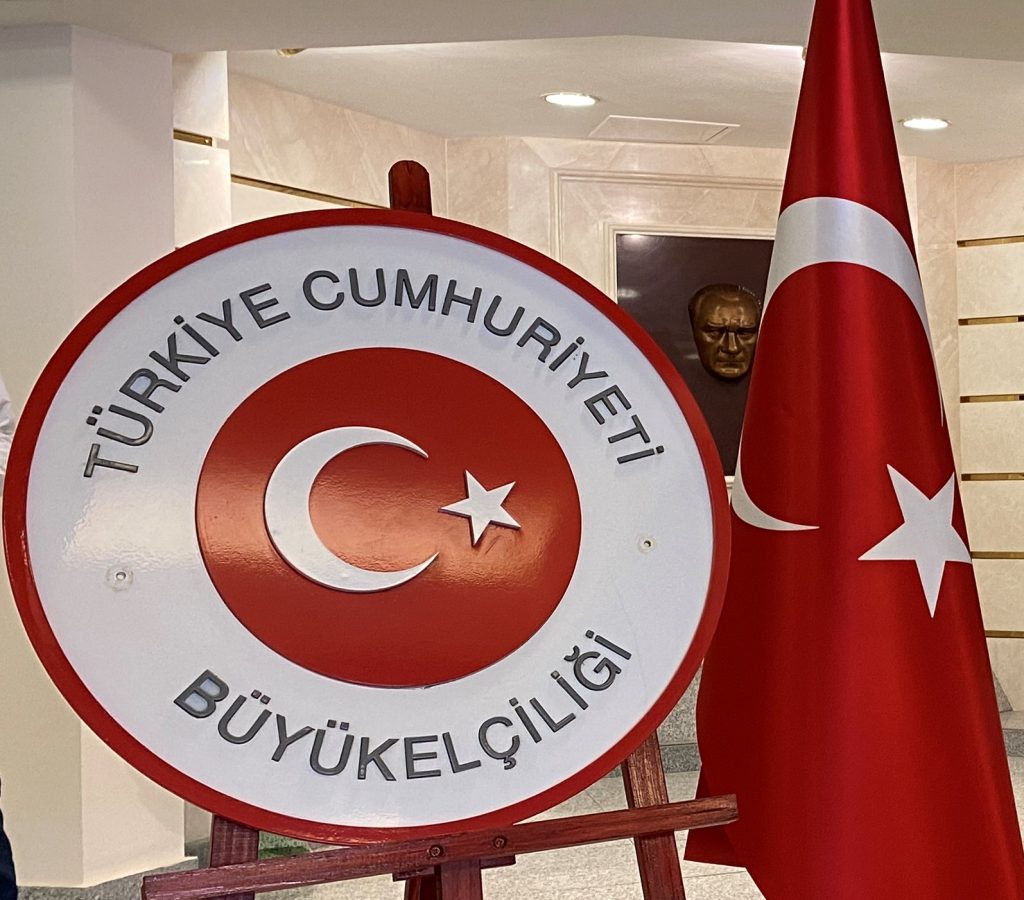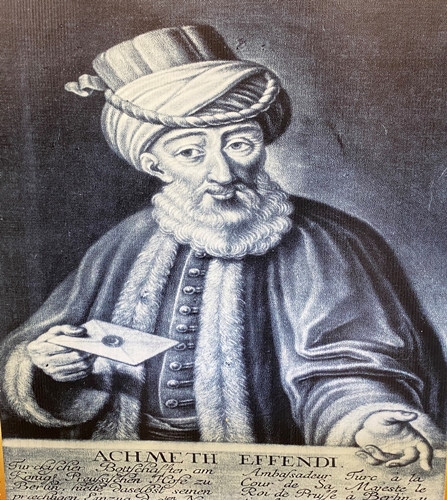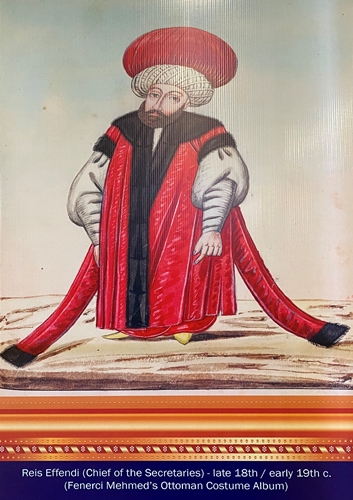nCa News and Commentary
The embassy of Türkiye in Turkmenistan hosted on 2 May 2023 an event to mark the 500 years of the Turkish Foreign Ministry. A photo exhibition was arranged in the embassy to show some key personalities and occasions in the long history of the diplomacy of the Ottoman Empire, merging with the modern-day Republic of Türkiye.
It coincided with the unveiling of the new plaque at the entrance of the embassy.
Here is the text of the speech of Ambassador Togan Oral:
Esteemed Ambassadors, Distinguished Members of the Press, Dear Colleagues, Ladies and Gentlemen,
It is a great pleasure for me to host the photo exhibition to celebrate 500 years of Turkish Foreign Service, on the 31st anniversary of the opening of this Embassy, as the very first Embassy opened in Ashgabat, on 2nd of May 1992.
Today also marks the 103th birth-day of the Turkish Ministry of Foreign Affairs.
On this very symbolic day for us, we are delighted to unveil the new Emblem of our Embassy.
As you will see soon, the new Emblem is decorated with 16 stars, representing the 16 independent Turkish states throughout the history.
In fact, our emblem is identical with all other Turkish Embassies around the world, but it probably stands here the best, as many of those stars symbolize the thousands of years of our common history with Türkmenistan.
Esteemed guests, Having established 16 states and ruling a vast geography for thousands of years, Turks have accumulated a vast experience of diplomacy on our long march from Central Asian steppes to Europe.
Carrying this tradition through our journey to our present homeland, Anatolia, known as the cradle of Diplomacy, we embraced its rich heritage of diplomatic history as well. One of the photos in the exhibition, shows the 2300 year old Treaty of Kadesh, the earliest known surviving peace treaty in history, found in Anatolia.
Therefore it’s not an easy task to trace back Turkish diplomacy. Yet, if we need to mark the beginning of the institutionalized foreign service, then it would be 1523, when the office of Reis-ül Küttap was established.
Starting in 1523, the foreign affairs of the Ottoman Empire were conducted by the “Reis-ül Küttab”, “Head Secretary” until the 19th Century. In 1793 the first Turkish permanent Embassy was established in London.
In fact, the Ambassadors of the Ottoman Empire appointed particularly to European capitals, not only fulfilled their diplomatic duties, but also served as the pioneers of progress, by accelerating the modernization and reform in the Empire, following the developments in the West.
Therefore, The Foreign Service of the Republic of Türkiye is founded on these established legacy of Ottoman diplomacy and we still cherish this well-deserved reputation as the driving force of the modernization of the country.
I’m proud to say that Turkish Foreign Service is among the top diplomatic services, in terms of the quantity with 260 missions abroad, in terms of quality with fastest and widest consular service, in terms of the use of advanced technologies, as well as in terms of the gender equality with 79 women Ambassadors, and 43 percent women representation in decision making level.
Dear guests, Turkish Ministry of Foreign Affairs was officially established on May 2, 1920, 103 years ago today, even before the proclamation of the Republic, even at the outset of the independence war, as part of the first National Government.
It was established with extremely limited resources, yet performed the functions and duties in a diligent and committed manner despite all the hardships of the war time and played an important role in the process leading up to the Lausanne Treaty, the founding document of the Republic.
Since the inception of the Republic to this day, the vision and principles of the leader and founder of the Republic, Atatürk, have guided Turkish foreign policy. His maxim “peace at home, peace in the world” continues to constitute the fundamental objective of this policy.
Accordingly, Türkiye has been pursuing an active and peaceful foreign policy since the 1930’s. Despite the pressures, the competent diplomacy pursued to safeguard the interests of the country prevented Türkiye from being dragged into World War II and the consequent devastation it would have entailed.
In line with the peace oriented and active foreign policy it pursues, Türkiye has become one of the founders of the Council of Europe and the United Nations, a staunch ally within NATO, an important party to OSCE, a candidate for European Union, the architect of the Organization of Turkic States uniting the Turkic World, and part of several other regional organizations.
In line with our “Entrepreneurial and Humanitarian Diplomacy” approach, Türkiye has been disposing its increasing capabilities for ensuring security, stability and prosperity in its immediate vicinity as well as at the international level.
As the country providing the highest amount of humanitarian aid in proportion to its national income, we run to the rescue of oppressed and needy persons, regardless of their origin, belief, and differences. Meanwhile Türkiye continues to host the highest number of refugees in the world.
In an environment beset by conflict and instability, we strive to set up a peace and prosperity zone around us, from ending the humanitarian tragedy in Syria to finding a solution to the Russia-Ukraine crisis.
Dear collegues, In this exhibition, we tried to reflect within a very limited space, the main pillars and historical moments of Turkish Foreign Policy in a chronological perspective.
And its not all about joyful moments. We wanted also to share with you the grief that we experienced in the 1970’s as a result of a wave of assasinations directed at Turkish diplomats and their families serving in missions abroad, carried out by the Armenian terrorist organization ASALA, claiming the lives of 34 officials of the Turkish Foreign Service, including five Ambassadors.
Esteemed guests, I’m proud to address you today, as the Ambassador of the first country to recognize Independent Turkmenistan and to establish the first diplomatic mission in Ashgabat.
Ever since this embassy is established, Türkiye and Turkmenistan cherish exemplary relations based on the historical, cultural, linguistic, religious and kinship ties between our brotherly people.
Thanks to these solid and strong foundations being laid, I am fully convinced that our deep-rooted relations will be cherished and further developed with the contribution of our mission.
With these thoughts and feelings, on the occasion of the 500th year of Turkish Foreign Service, 103th birthday of the Turkish Foreign Ministry and the 31st anniversary of the establishment of our Embassy in Ashgabat, I would like to extend my appreciation to you for joining our joy and pride today.
Now I would like to invite you outside for the unveiling of the new sign of our Embassy.
Thank you!
nCa Commentary by Tariq Saeedi
I had a short conversation with Togan Bay (Ambassador Togan Oral) before the start of the event. He agreed that the roots of the Turkic diplomacy were traceable deep into the dawn of the written history and the 500 years anniversary just marks the formalization of the diplomacy with the opening of permanent diplomatic missions in the key capitals.
The real substance here is not the pride in the glorious history though that is perfectly justifiable on its own.
The shifting tectonic plates of the world order are shaping the relevance. The poles are moving shakily and the world is groping for the new handles to return to some semblance of stability.
The Turkic world is ready to play its role – again.
The new plaque at the entrance of the Turkish embassy in Ashgabat is adorned with 16 stars. This, as mentioned by Ambassador Oral in his speech, denotes the 16 states – actually 16 empires – formed by the Turkic people throughout the history.
Here are these 16 stars:
| Flag (fictional) |
Name | Turkish name | Leader | Dates (Gregorian) |
|---|---|---|---|---|
 |
Xiongnu | Büyük Hun İmparatorluğu | Mete Han | 220 BC–46 BC |
 |
South Xiongnu | Batı Hun İmparatorluğu | Panu | 48–216 |
 |
Hunnic Empire | Avrupa Hun İmparatorluğu | Attila | 375–469 |
 |
Hephthalite Empire | Akhun İmparatorluğu | Aksunvar | 390–577 |
 |
Turkic Khaganate | Göktürk İmparatorluğu | Bumin Kağan | 551–744 |
 |
Avar Khaganate | Avar İmparatorluğu | Bayan Kağan | 565–835 |
 |
Khazar Khaganate | Hazar İmparatorluğu | Tong Yabgu Kağan | 651–983 |
 |
Uyghur Khaganate | Uygur Devleti | Kutluğ Kül Bilge Kağan | 744–840 |
 |
Karakhanid Khanate | Karahanlılar | Kül Bilge Kadir Han | 840–1212 |
 |
Ghaznavids | Gazneliler | Sabuktigin | 977–1186 |
 |
Seljuk Empire | Büyük Selçuklu İmparatorluğu | Chagri Bey | 1037–1194 |
 |
Khwarazmian dynasty | Harzemşahlar | Muhammad II of Khwarezm | 1077–1231 |
 |
Golden Horde | Altınordu Devleti | Batu Khan | 1236–1502 |
 |
Timurid Empire | Büyük Timur İmparatorluğu | Timur | 1368–1501 |
 |
Mughal Empire | Babür İmparatorluğu | Babur | 1526–1858 |
 |
Ottoman Empire | Osmanlı İmparatorluğu | Osman I | 1299–1922 |
Source: Wikipedia
With this rich legacy, the OTS (Organization of Turkic States) is simultaneously consolidating and developing the new formats for cooperation within the Turkic World and with the world that has never been a stranger to the Turkic World.
“Peace at home, Peace in the world.” /// nCa, 3 May 2023
Here are some pictures from the event:
Here is a sampling from the photo exhibition:
